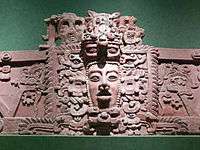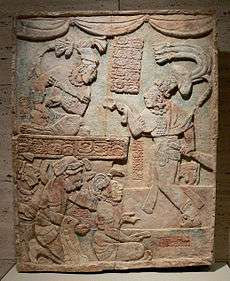Maya society
 |
| Maya civilization |
|---|
| History |
| Preclassic Maya |
| Classic Maya collapse |
| Spanish conquest of the Maya |
Maya society concerns the social organization of the Pre-Hispanic Mayas, its political structures and social classes.
Kingdom, Court, and Royal
A Classic period Maya polity was a small kingdom (ajawil, ajawlel, ajawlil) headed by a hereditary ruler – ajaw, later k’uhul ajaw. Both terms appear in early Colonial texts including Papeles de Paxbolón where they are used as synonyms for Aztec and Spanish terms for rulers and their domains. These are tlatoani and tlahtocayotl in Nahuatl, and the Spanish words rey, majestad, and reino and señor for ruler/leader/lord and señorío or dominio of realm. Such kingdoms were usually no more than a capital city with its neighborhood and several dependent towns (similar to a city-state). There were also larger polities that controlled larger territories and subjugated smaller polities; the extensive systems controlled by Tikal and Caracol serve as examples of these.
Each kingdom had its name that did not necessarily correspond to any locality within its territory. Its identity was that of a political unit associated with a particular ruling dynasty. For instance, the archaeological site of Naranjo was the capital of the kingdom of Saal. The land (chan ch’e’n) of the kingdom and its capital were called Wakab’nal or Maxam and were part of a larger geographical entity known as Huk Tsuk. Despite constant warfare and eventual shifts in regional power, most kingdoms never disappeared from the political landscape until the collapse of the whole system in the 9th century. In this respect, Classic Maya kingdoms were similar to late Postclassic polities encountered by the Spanish in Yucatán and Central Mexico: some polities were subordinate to hegemonic centers or rulers through conquest and/or dynastic unions and yet even then they persisted as distinct entities.

Mayanists have been increasingly accepting the "court paradigm" of Classic Maya societies that puts the emphasis on the centrality of the royal household and especially the person of the king. This approach focuses on the totality of Maya monumental spaces as the embodiment of the diverse activities of the royal household. It considers the role of places and spaces (including dwellings of royalty and nobles, throne rooms, temples, halls and plazas for public ceremonies) in establishing and negotiating power and social hierarchy, but also in producing and projecting aesthetic and moral values that define the order of a wider social realm.
Spanish sources invariably describe even the largest Maya settlements of Yucatán and Guatemala as dispersed agglomerations of dwellings grouped around the temples and palaces of the ruling dynasty and lesser nobles. Though there was economic specialization among Classic period Maya centers (see Chunchucmil, for example), it was not conducted at a scale similar to that of the Aztec capital of Tenochtitlan. Some argue that Maya cities were not urban centers[1] but were, instead, structured according to and conceptualized as enormous royal households, the locales of the administrative and ritual activities of the royal court. Within the theoretical framework of this model, they were the places where privileged nobles could approach the holy ruler, where aesthetical values of the high culture were formulated and disseminated, and where aesthetic items were consumed.[2] They were the self-proclaimed centers and the sources of social, moral, and cosmic, order. The fall of a royal court as in the well-documented cases of Piedras Negras or Copán would cause the inevitable ‘death’ of the associated settlement.
Social classes
Scribes
Scribes held a prominent position in Maya courts and had their own patron deities (see Howler monkey gods and Maya maize god). They are likely to have come from aristocratic families. It appears that some scribes were attached to the royal house, while others were serving at temples and were, perhaps, counted among the priests. It seems likely that they were organized hierarchically. Maya art often depicts rulers with trappings indicating they were scribes or at least able to write, such as having pen bundles in their headdresses. Additionally, many rulers have been found in conjunction with writing tools such as shell or clay ink pots.
Kinship
Ancient Maya kinship and descent have alternatively been described as patrilineal, matrilineal, and bilateral. Maya political organization has been characterized as both segmentary (involving well-defined lineages and clan-like structures) and centralized.
Body modifications
Ancient Mayans placed a high value on certain extreme body modifications, often undergoing tedious and painful procedures as a rite of passage, an homage to their gods, and as a permanently visible status symbol of their place in society that would last a lifetime, and into their afterlife.
High-status Mayan mothers would artificially induce crosseyedness (strabismus) and would strap on boards to flatten the foreheads of high-born infants as a lifelong sign of noble status.[3] The eye condition was used to honor Kinich Ahau, the crosseyed sun god of the Mayans. Once their permanent teeth had arrived, adolescent warriors had their teeth filed to sharp points to give them a fierce appearance, and as a further mark of status.[4] High-status women often had their teeth filed, in different patterns, and would have jadeite, hematite, pyrite, turquoise, or other decorations inset into holes drilled in their teeth.[4]
Warfare
The Mayas employed warfare in each period of their development for the purposes of obtaining sacrificial victims, settling competitive rivalries, acquiring critical resources and gaining control of trade routes. Warfare was important to the Maya religion, because raids on surrounding areas provided the victims required for human sacrifice, as well as slaves for the construction of temples. Large-scale battles were also fought to determine and defend territories as well as secure economic power. The Mayas defended their cities with defensive structures such as palisades, gateways, and earthworks. Some cities had a wall within the outer wall, so advancing enemies would be trapped in a killing alley, where they could be slaughtered in great number. During the post-Classic period, the amount of internal warfare increased greatly as the region became more politically fragmented. Armies were enlarged, and in some cases mercenaries were hired. The resulting destruction of many urban centers contributed to the decline of the Maya.
Military organization
The ruler of a Maya city was the supreme war captain. Some only dictated military activity, while others participated in the battle. There was a core of warriors that served year-round as guards and obtained sacrificial victims, but most large Maya cities and religious centers had militias. These men were paid to fight for the duration of the battle. Then they would return to their fields or crafts. The militia units were headed by nacoms, hereditary war chiefs, that employed ritual as well as strategic methods in warfare. Some nacoms were only chief strategists, and the troops were led into battle by batabs, or officers. In a large war, even commoners who did not have weapons would fight using hunting tools and by hurling rocks. “In the highlands, women occasionally fought in battles according to native chronicles” (Foster, 144).
Tactics
The jungle terrain of Mesoamerica made it difficult for large armies to reach their destination. The warriors who were familiar with the battle landscape could strategically retreat into familiar wilderness. Other war tactics included the siege of cities and the formation of alliances with lesser enemies to defeat more prominent ones. There is evidence that canoes were used to attack cities, located on lakes and rivers. In the late Classic period, destructive warfare methods, such as burning, became more prevalent.
Rituals
Warfare was a ritual process, which was believed to be sanctioned by the gods. Military leaders, in many instances, also had religious authority. Before going into battle, the armies would call upon the gods with dances and music of drums, whistles, conch shell horns and singing. The drumming and war cries would signify the start of the battle. The armies also carried religious idols into battle to inspire the warriors. They fought fiercely because they believed that death on the battle field secured them eternal bliss, whereas capture by the enemy was regarded as worse than any death. When an enemy was defeated, the victorious army exploited the religious icons and sometimes humiliated the defeated leader with prolonged captivity. The treatment of prisoners by the victorious was brutal and often ended in decapitation. The Maya also had a ritual of giving blood. The reason that they gave blood was to show respect to their gods. They gave blood from their genitals and tongue. Afterwards, they would drip their blood onto a piece of paper and burn it into the sky to show respect to their gods.
Weapons and uniform
Weapons used by the Maya included spear-throwers known as atlatls, blowguns, obsidian spiked clubs, spears, axes, lances and knives tipped with flint or obsidian blades.[5] Bow and arrows were also used, but not as extensively. Though there were few helmets, they used decorated shields made from woven mats, wood and animal skins for protection. The Maya war leaders dressed to inspire their warriors and terrify their enemies. They usually wore padded cotton armor, a mantle with religious insignia, and elaborate wooden and cloth headdresses, that represented the animal spirit or “way” of the warrior. Metal was not used in battle because of the limited supply.
Notes
- ↑ Sanders and Webster 1988:523-524.
- ↑ Sanders and Webster 1988:524.
- ↑ "Maya Culture". Guatemala: Cradle of the Mayan Civilization. authenticmaya.com. Retrieved 2012-04-13.
- 1 2 "Maya Medicine". Guatemala: Cradle of the Mayan Civilization. authenticmaya.com. Retrieved 2012-04-13.
- ↑ Foster, Lynn V. (2002). Handbook to life in the ancient Maya world. New York, NY: Oxford University Press. pp. 145–146. ISBN 978-019-518363-4.
References
- Aoyama, Kazoa. (2005) Classic Maya Warfare and Weapons: Spear, dart, and arrow points of Aguateca and Copan. Ancient Mesoamerica 16(2): 291-304.
- Barrett, Jason and Andrew Scherer. (2005) Stones, Bones, and Crowded Plazas: Evidence for Terminal Classic Maya Warfare at Colha, Belize. Ancient Mesoamerica 16(1): 101-118.
- Bunson, Margaret R., and Stephen M. Bunson. (1996) Warfare, Maya. Encyclopedia of Ancient Mesoamerica. New York: Facts On File, Inc., 1996.
- Foster, Lynn V. (2001) Handbook to Life in the Ancient Maya World. New York: Facts on File, Inc.
- Martin, Simon, and Mary Miller. Courtly Art of the Ancient Maya. New York: Thames & Hudson, 2004.
- Sanders, William and David Webster (1988) The Mesoamerican Urban Tradition. American Anthropologist 90(3): 521-546.
External links
- Maya Warfare Research
- Weapons of the Maya - World Museum of Man Collection
- Maya Society records, MSS 279 at L. Tom Perry Special Collections, Brigham Young University